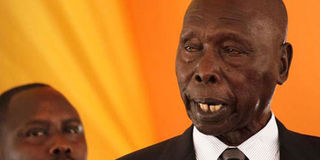Prime
Ex-Kenyan President Moi to pay KSh1bn fine for land grab

Former Kenyan President Daniel arap Moi. NMG FILE PHOTO
What you need to know:
- Experts hired by the Chelugui family had placed the value of the land at Sh1.71 billion and put loss of potential profits at KSh244 million. The Uasin Gishu’s valuer had pegged the land at KSh820 million.
On September 21, 1983, former President Daniel arap Moi forcibly took over a 53-acre piece of land owned by ex-chief Noah Kipngeny Chelugui through a scheme that involved ordering lands officials to make the necessary transfers to register the property, and then, 24 years later, he sold it to a firm owned by the Jaswant Rai family.
PRIME PROPERTY
Then all went quiet until last week, when the High Court in Eldoret ruled that the former President’s move was illegal and ordered both Mr Moi and Rai Plywood (K) Limited to pay Mr Chelugui’s family KSh1 billion — the current market value of the prime property.
Rai Plywood has occupied the land since 2007 — two years after Mr Chelugui died — and has been using it to grow wheat.
The firm told High Court judge Antony Ombwayo that it bought the land from Mr Moi in 2007 after doing a thorough search that showed there was no claim to the prime property by anyone other than the former President.
Mr Chelugui’s 85-year-old wife Susan and son David sued Mr Moi, Rai Plywood, the District Land Registrar, Uasin Gishu District, the Registrar of Titles and the National Land Commission in 2014.
The District Lands Registrar and Uasin Gishu District opposed a demand for damages from them, arguing that they were “bound by orders from above by the first respondent (Mr Moi)” in the land-grab scheme.
Mr Moi furnished the court with a title deed and white card but was unable to provide any proof of how he bought the land.
DISPOSSESSED
The former President and Rai Plywood insisted that the suit was a claim for land veiled as a constitutional petition. Had the case been treated purely as a land case, it would have been time-barred because Kenya’s laws provide a 12-year window to sue for such a claim. With constitutional petitions, however, a judge can overlook the time taken to bring the matter to court. Justice Ombwayo noted that the nature of the people involved — high-ranking government bureaucrats on instruction from the President — made it necessary to accept the suit as a constitutional petition.
“There is no iota of evidence as to how the former President was registered as the proprietor of the suit land, which was part of (property) that belonged to Noah Kimngeny Chelugui. The state counsel stated that these were orders from above by the first defendant, who was the President (Moi),” said the judge.
“The court finds that the statement borders on illegality, impunity and procedural impropriety. This court cannot protect property that was acquired through impropriety.”
In January 1982, Director of Surveys Henry Wambua received verbal instructions from then State House Comptroller Abraham Kiptanui ordering him to assess the property. Mr Wambua complied and informed the Commissioner of Lands, named in court documents as W S Maithukia.
Justice Ombwayo held that the letter from Mr Wambua was evidence of interference by State House, which led to the land being subdivided unprocedurally and ending up in Mr Moi’s name.
“This court finds that the petitioners were illegally dispossessed of the suit land,” noted the judge. “Though cancellation of the title is an available remedy, the appropriate remedy is compensation in terms of the value of the land without improvements as the respondents have heavily invested on it and have been in possession for a long period of time.
WHITE SETTLER
“The parcel of land is occupied by entities who are not recognised by the owners. At the time of inspection, the parcel of land was largely not developed but had a portion developed with a petrol station …. However, I find evidence that the property is prime within the municipality of Eldoret and along Uganda Road, and therefore KSh1,060,000,000 is a commensurate compensation to the petitioners.”
The property only housed a Kobil petrol station at the time Mr Moi took possession in 1983.
The judge, however, declined to award the Chelugui family compensation for the profits they would have reaped had they developed the land or used it to transact business.
The Cheluguis’ lawyer, Mr William Arusei, told Justice Ombwayo that the land was initially part of a 3,300-acre piece of land owned by a white settler named Jacob Hendrik EngelBrecht. Mr Chelugui teamed up with Nathaniel Kiptalam Langat, Thomas Kipkosgei Yator, Cherop Arap Maritim and William Kimngeny Letting to buy Mr EngelBrecht’s land in 1965.
The property was first registered in Mr Moi’s name on September 21, 1983, and the court observed that Mr Moi was not a member of N K Langat & Partners, the original owner of the land that was subdivided into six portions.
Experts hired by the Chelugui family had placed the value of the land at Sh1.71 billion and put loss of potential profits at KSh244 million. The Uasin Gishu’s valuer had pegged the land at KSh820 million.



